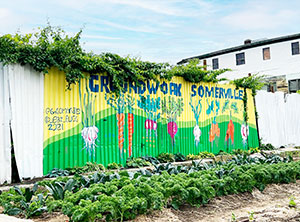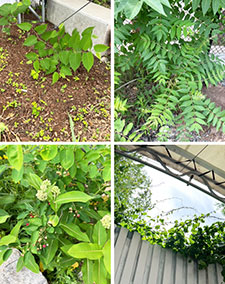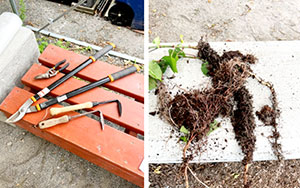
Groundwork Somerville recently held a workshop at the South Street Farm on dealing with invasive plants in the garden. — Photos by Luda Tang
By Luda Tang
Groundwork Somerville, a nonprofit organization dedicated to food and environmental justice, launched a workshop on June 11 at the South Street Farm teaching residents how to identify and remove invasive plants that may appear in their gardens.
Alexandra Lennon-Simon, Executive Director of Groundwork Somerville, started the workshop by asking attendees how to define “invasive” plants. This question was followed by one attendee’s confusion about who gets to decide which species are invasive.
Lennon-Simon helped participants to understand the term by explaining the difference between weed and invasive plants. The former can be interpreted as something people don’t want in the community, but “invasive” species are more hostile, ones that are brought from other regions have a tendency to spread out of control in new habitats and push out other native species.

Some invasive species that were shown at the South Street Farm.
When dealing with invasive plants, Lennon-Simon informed attenders that it is impossible to get rid of them once they are established in the region. “There is no one perfect solution. You have to show regular diligence,” she said.
On the sheet identifying common invasive plants in Massachusetts that was handed out by Lennon-Simon, she specially pointed out species like sycamore maple, tree-of-heaven, swallow-wort, garlic mustard, and a common reed that might be found in people’s backyards.
Some of the invasive plants are easily identifiable with their unique shape. Sycamore maple is shaped like a hand palm, while the shape of tree-of-heaven is like a feather. When people find an unknown species and need the help of an expert.
Lennon-Simon suggested trying to involve the five senses to describe the species. In addition to the visual shape, people can also depict their touch, smell, and taste. However, since some plants might be poisonous, people should be cautious about tasting.
After learning how to identify the invasive plants, Lennon-Simon introduced a few ways to remove them. The first is an easy one that doesn’t involve tools: pouring boiling water over the plants. This way can effectively kill the aggressive plants, but the disadvantage is it also kills the good stuff. It should only be applied in some urgent circumstances.
Using sheet plastic to cover plants is another eco-friendly way to remove invasive plants. The method can be most effective in sunny areas since the heat generated under the plastic can kill any plants beneath it. But it’s also why it is best to have no other plants in the area.
There are also some tools that can help people to remove invasive plants. Lopper, clipper, and cape codder are three most commonly used ones. Invasive plants usually have long extended roots, and a cape codder can help to go deep under the soil and pull the roots out.

At the end of the workshop, several participants tried to use the tools to remove some invasive plants in the farm.















Reader Comments